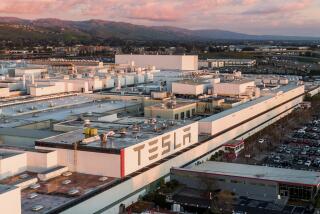Refinery burn-off may have run afoul of new AQMD rule
- Share via
In the first apparent test of a beefed-up “anti-flaring” law, regional air regulators said Friday they are investigating an incident at the ConocoPhillips refinery in Wilmington late Thursday that sent flames shooting high into the air.
The incident is one of half a dozen that have occurred this week, within days of an expanded ban on flaring by the South Coast Air Quality Management District that took effect Monday.
Three ConocoPhillips smokestack flares could be seen as far north as the Century Freeway and as far south as the Palos Verdes Peninsula during the Thursday burn-off, which began about 8:30 p.m. and lasted about 45 minutes, officials said.
The tougher regulations ban open burn-off of excess gases from South Bay refineries except in emergencies or during planned shutdowns, start-ups or other “essential” operations.
Violators can face fines of $1,000 or more. Emissions from such events are also supposed to be cut sharply in coming years.
Four of this week’s events were planned. The other unplanned event, which was at a BP facility, is also being investigated, said South Coast AQMD spokesman Sam Atwood. Few other details were immediately available.
ConocoPhillips spokesman Andy Perez said Friday that the flaring at the refinery at 1400 W. Anaheim St. was not an emergency but a safety precaution after workers noticed that a key piece of equipment that boils oil was malfunctioning.
About 8:30 p.m., he said, “one of our units experienced an equipment malfunction which resulted in some flaring. Flaring is a safety mechanism that refineries use to help release gases. It was not catastrophic, it was not significant. It is a big visual. At no time were we in danger of exploding or elevating beyond control.”
Atwood said Friday that three inspectors were sent to the plant Thursday after receiving calls from residents and the media. He said the refinery had reported the incident as well, as required. Atwood said the inspectors arrived after the flaring was done, but that one had spoken to a refinery operations employee who knew what had happened. He said the plant was also required to measure emissions during flaring, and to submit results to the agency in coming weeks.
It was not clear whether the flaring was a violation. “The investigation is continuing,” Atwood said.
Firefighters at the scene and refinery spokesman Perez said that Thursday’s heavy winds might have intensified the flames.
Nearby residents have long complained of frequent flaring at the ConocoPhillips refinery, which is west of the Harbor Freeway and north of the Port of Los Angeles. A widespread September 2005 power outage forced ConocoPhillips and two other refineries to shut down operations and ignite their flare stacks. The incident exacerbated local concerns about potential pollution from such flaring.
Perez said that ConocoPhillips had added workers and installed new equipment to help prevent unnecessary flaring, and that this week’s incident was the first significant one of any kind since 2005.
Sulfur oxide emissions from flaring contribute to fine particulate pollution, or soot, which has been linked to increased hospital admissions and premature deaths from respiratory and heart problems. Low levels of sulfur oxide can also exacerbate asthma symptoms.
The tougher rules are designed to reduce sulfur oxide emissions from about 2 tons a day in 2003 to under half a ton by 2012.
deborah.schoch@latimes.com
More to Read
Sign up for Essential California
The most important California stories and recommendations in your inbox every morning.
You may occasionally receive promotional content from the Los Angeles Times.













